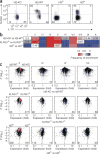Transcriptional insights into the CD8(+) T cell response to infection and memory T cell formation
- PMID: 23396170
- PMCID: PMC3689652
- DOI: 10.1038/ni.2536
Transcriptional insights into the CD8(+) T cell response to infection and memory T cell formation
Abstract
After infection, many factors coordinate the population expansion and differentiation of CD8+ effector and memory T cells. Using data of unparalleled breadth from the Immunological Genome Project, we analyzed the CD8+ T cell transcriptome throughout infection to establish gene-expression signatures and identify putative transcriptional regulators. Notably, we found that the expression of key gene signatures can be used to predict the memory-precursor potential of CD8+ effector cells. Long-lived memory CD8+ cells ultimately expressed a small subset of genes shared by natural killer T and γδ T cells. Although distinct inflammatory milieu and T cell precursor frequencies influenced the differentiation of CD8+ effector and memory populations, core transcriptional signatures were regulated similarly, whether polyclonal or transgenic, and whether responding to bacterial or viral model pathogens. Our results provide insights into the transcriptional regulation that influence memory formation and CD8+ T cell immunity.
Conflict of interest statement
The authors declare no competing financial interests.
Figures






Similar articles
-
The transcriptional regulators Id2 and Id3 control the formation of distinct memory CD8+ T cell subsets.Nat Immunol. 2011 Nov 6;12(12):1221-9. doi: 10.1038/ni.2158. Nat Immunol. 2011. PMID: 22057289 Free PMC article.
-
E2A-regulated epigenetic landscape promotes memory CD8 T cell differentiation.Proc Natl Acad Sci U S A. 2021 Apr 20;118(16):e2013452118. doi: 10.1073/pnas.2013452118. Proc Natl Acad Sci U S A. 2021. PMID: 33859041 Free PMC article.
-
Early transcriptional and epigenetic regulation of CD8+ T cell differentiation revealed by single-cell RNA sequencing.Nat Immunol. 2017 Apr;18(4):422-432. doi: 10.1038/ni.3688. Epub 2017 Feb 20. Nat Immunol. 2017. PMID: 28218746 Free PMC article.
-
The interface between transcriptional and epigenetic control of effector and memory CD8⁺ T-cell differentiation.Immunol Rev. 2014 Sep;261(1):157-68. doi: 10.1111/imr.12205. Immunol Rev. 2014. PMID: 25123283 Free PMC article. Review.
-
Transcriptional control of effector and memory CD8+ T cell differentiation.Nat Rev Immunol. 2012 Nov;12(11):749-61. doi: 10.1038/nri3307. Epub 2012 Oct 19. Nat Rev Immunol. 2012. PMID: 23080391 Free PMC article. Review.
Cited by
-
Fate induction in CD8 CAR T cells through asymmetric cell division.Nature. 2024 Sep;633(8030):670-677. doi: 10.1038/s41586-024-07862-7. Epub 2024 Aug 28. Nature. 2024. PMID: 39198645 Free PMC article.
-
Urine scRNAseq reveals new insights into the bladder tumor immune microenvironment.J Exp Med. 2024 Aug 5;221(8):e20240045. doi: 10.1084/jem.20240045. Epub 2024 Jun 7. J Exp Med. 2024. PMID: 38847806
-
BASiCS workflow: a step-by-step analysis of expression variability using single cell RNA sequencing data.F1000Res. 2024 May 7;11:59. doi: 10.12688/f1000research.74416.1. eCollection 2022. F1000Res. 2024. PMID: 38779464 Free PMC article.
-
Pregnancy dedifferentiates memory CD8+ T cells into hypofunctional cells with exhaustion-enriched programs.JCI Insight. 2024 May 21;9(13):e176381. doi: 10.1172/jci.insight.176381. JCI Insight. 2024. PMID: 38771643 Free PMC article.
-
RAR-related orphan receptor alpha and the staggerer mice: a fine molecular story.Front Endocrinol (Lausanne). 2024 May 3;14:1300729. doi: 10.3389/fendo.2023.1300729. eCollection 2023. Front Endocrinol (Lausanne). 2024. PMID: 38766309 Free PMC article. Review.
References
Publication types
MeSH terms
Substances
Associated data
- Actions
Grants and funding
LinkOut - more resources
Full Text Sources
Other Literature Sources
Molecular Biology Databases
Research Materials

